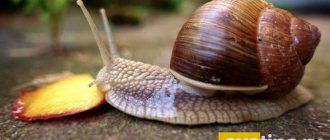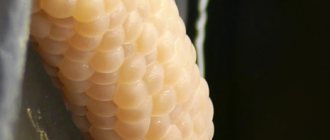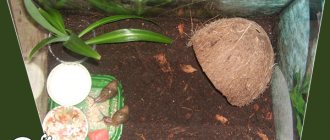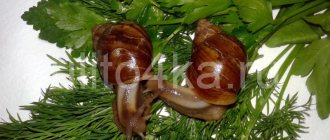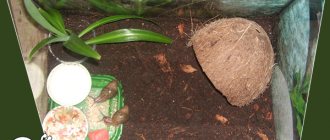In previous articles, I talked in detail about chalk and sepia for the Achatina snail. Today we will talk about eggshells, their preparation and use as a mineral feed for Achatina snails.
I will share with you a recipe for a calcium mixture made from eggshells, which snails really like.
Why does a snail need calcium?
Snail shells are mainly composed of calcium carbonate CaCO3 and a binding protein (conchiolin). As the mollusks grow, they secrete a substance that increases the size and thickness of the shell. This substance is secreted by glands on the skin fold - the mantle, and it consists mainly of calcium carbonate. Essentially, snails consume calcium, process it and grow new coils, which is how shells grow. That is why young individuals and mollusks with damaged shells need increased amounts of this substance.
Calcium is also necessary for the formation of healthy egg clutches.
Snails receive this useful substance not only from food, but also absorb it through the sole of their feet when crawling.
What not to give to snails
Snails are strictly prohibited from consuming table salt and foods containing salt, citric or other acid, sugar and starch.
Akhatins are prohibited:
- legumes;
- fried vegetables;
- candied fruits;
- smoked products;
- pasta;
- semolina;
- salt and everything salty;
- spices;
- dried dried fruits (figs, raisins);
- raw potatoes.
Through trial and error, it was determined that Achatina should not be fed hot and spicy herbs (onions, garlic, mustard salad, hot red peppers) and citrus fruits.
Diet at home
Under natural conditions, snails regulate their diet themselves, consuming the necessary products. And at home this is done by the owner of the shellfish, who must know what to feed the snails at home. It should also be understood that the correct diet for domestic snails should include the following food groups:
Plant food
This food should be the basis of every snail's diet. Vegetables, fruits and herbs contain many vitamins, micro- and macroelements, so necessary for shellfish.
How much calcium does a snail need?
How can a snail be given calcium and how much does it need? In the snail's terrarium, sepia, ground eggshells or chalk, whatever you offer your pet, should always be freely available.
You can sprinkle crushed calcium on your daily plant food or mix the calcium mixture into the soil.
Feed chalk or dolomite flour is also used to neutralize the acid-base environment of snail litter.
But sprinkling calcium on fruits and vegetables that contain large amounts of acid is not recommended. It is better to feed such products separately.
Sometimes inexperienced snail keepers are interested in the question: is it possible to overfeed the snail with calcium? No, the snail will eat as much as it needs.
The snail's diet can be varied with other foods containing calcium in small quantities. This:
- Vegetables – cabbage, broccoli, watercress, spinach. They are fed fresh, except for cabbage, which it is advisable to first scald with boiling water and cool.
- Seeds - sesame, sunflower seeds, mustard and rapeseed, poppy seeds, buckwheat, rice and nuts (except peanuts). These products are not often offered to pets in ground form as a treat for their main meal. It is necessary to grind before feeding; it is not worth storing for future use.
- Bone, fish, meat and bone meal, feed for poultry - they are fed infrequently and in small quantities, once a week will be enough. After feeding, remove any leftovers immediately. Before feeding your pets such food, study the composition and expiration dates.
- Milk – occasionally, as a treat.
In order for calcium to be well absorbed, it is necessary to introduce the following foods containing vitamin D into the snail’s diet:
- Green parts of dandelion, nettle, alfalfa, woodlice and other plants;
- Mushrooms;
- Sea fish;
- Milk.
Don't forget about other vitamins that are found in various fruits, vegetables and herbs. Provide your pet with a varied and nutritious diet, and the snail will not have problems with its shell. For a list of what to feed your snail, see here.
Bottom line
Calcium for snails is not only one of the most important components of their diet. With the help of this substance, snails build up their external skeleton - the shell, which contains all the internal organs. A strong shell, in turn, allows you to hide in case of danger or wait out unfavorable conditions. From all this we can conclude that calcium is vital for the snail and should be freely available to the mollusk. Feed your pets correctly, and they will delight you throughout their short lives. Read here what you can feed your pet snails.
What do Achatina eat?
African snails in nature feed on leaves, shoots and fruits of various plants. Many species of these animals are pests in natural conditions. They can cause significant damage to crops by eating them. But in Europe and Russia, due to the climate, Achatina does not pose a threat to established ecosystems.
Achatina are vegetarians by nature. Despite the fact that their homeland is Africa, they enjoy our local vegetables and fruits, and the list of permitted products is huge. In a terrarium, they happily eat various local vegetables, fruits and herbs.
Many people include sweet fruits in snail food. In principle, shellfish can choose one product and eat it with pleasure, but still, variety should be added to their diet. It should include fiber, minerals (calcium) and proteins. Vitamin greens, dandelion leaves, etc. are especially useful. Let's find out more about this.
✅ Vegetables and fruits
Before offering vegetables and fruits to Achatina, they must be washed and cut into small pieces. Pumpkin, zucchini and other dense vegetables are grated for small snails. All products should be at room temperature.
Achatina loves the sweet pulp of bananas, but babies can’t have it. They bite into the flesh and then cannot get out of there. Snails quickly get used to bananas, and then they don’t want to eat anything else. Therefore, it is better to give bananas 1-2 times a week.
Avocados, peaches, cucumbers, non-acidic varieties of tomatoes are delicacies for Achatina. They eat these fruits with great pleasure.
Classic vegetables (carrots, beets, cabbage of all varieties, sweet peppers) can be given daily without restrictions.
You can also add any melons to your diet. Potassium, iron, vitamins, and fiber contained in watermelon will only be beneficial.
Attention ! It should be remembered that a high content of nitrates in products can lead to the death of the snail. Unscrupulous melon growers often use nitrates to speed up ripening. It is necessary to choose watermelons and other melons that have ripened naturally, without nitrate feeding.
Fruits that snails can eat:
- apricots;
- avocado;
- a pineapple;
- watermelon;
- bananas;
- cherry;
- pears;
- melon;
- zucchini;
- carrot;
- nectarine;
- cucumbers;
- squash;
- beet;
- Bell pepper;
- plums;
- tomatoes;
- pumpkin;
- persimmon;
- zucchini;
- apples.
✅ Greens and herbs
Snails adore any juicy table greens. This could be parsley, celery, dill, dandelions, nettles, plantain.
What greens can Achatina eat:
- White cabbage;
- Brussels sprouts;
- cauliflower;
- clover;
- nettle;
- plantain leaves;
- lettuce leaves;
- birch foliage;
- oak foliage;
- linden foliage;
- raspberry foliage;
- currant foliage;
- burdock;
- alfalfa;
- woodlice;
- dandelions;
- parsley;
- chamomile;
- celery;
- dill;
- spinach.
⚫ Grapes
Snail breeders have been arguing about grapes for a long time. They came to the conclusion that it is possible to give grapes, but rarely, since Achatina quickly gets used to it and refuses other food. Grape leaves can be served fresh or dried. Grapes can be frozen for the winter and fed in small portions 1-2 times a week.
⚫ Strawberries and wild strawberries
Local species of snails adore strawberries and gobble them up in the garden beds without a twinge of conscience. This berry also attracts Achatina. You can prepare strawberries in the summer by freezing them and give them a little in the winter. Thawed berries retain all their beneficial qualities and will support shellfish during the long winter. They are rich in vitamins and minerals and have an antimicrobial effect.
⚫ Raspberry
Fresh green raspberry leaves are also beneficial for snails, as are the juicy, aromatic berries. They can be dried and used in the winter as top dressing. Fresh and defrosted berries can be safely placed in the feeder.
Berries that are allowed for Achatina:
- grape;
- strawberries;
- strawberry;
- raspberries.
✅ Dairy products
Milk is a valuable product that contains protein, calcium, and many useful microelements. Many snail breeders cannot agree on the benefits of milk for Achatina. Some say that there is no need to give dairy products to snails, because in their natural habitat they do not consume them. On the other hand, domestic Achatina are already accustomed to living with people and their diet may differ significantly from their wild relatives.
If you want to give milk to Achatina, then give low-fat milk (up to 2.5%), or even diluted milk. And then look at the pets’ reaction. In any case, it is not recommended to give dairy products daily.
Dairy
- low-fat sour cream;
- skimmed milk;
- skim cheese.
✅ Cereals, seeds and nuts
Cereals and nuts are usually given in mixtures in ground form.
Cereals
- buckwheat grain;
- corn;
- oats;
- millet;
- rice;
- rye;
- barley.
Seeds and nuts (raw)
- Walnut;
- pine nuts;
- cashew nuts;
- sesame;
- almond;
- flax seed;
- sunflower seed;
- pumpkin seeds;
- hazelnut.
✅ What else do snails eat?
Some Achatina are very fond of mushrooms. They can be consumed raw or dried. As a rule, these are champignons or oyster mushrooms. Mushrooms are often added to the protein mixture, and some snail breeders plant mushrooms directly in the soil where their pets live.
Many people notice that snails happily eat paper. This is natural, since paper is made from cellulose, and clean, unprinted paper will not harm domestic shellfish. Do not leave pieces of newspapers or printouts from under the printer in the container.
Fish food (daphnia) may also appeal to snails. It compensates for the lack of protein in the body.
Achatina eat with great pleasure dried fruits prepared at home (apples, pears, plums, etc.).
Other
- Mushrooms (edible)
- Fish food (daphnia);
- Dried fruits
- Blank paper.
What to feed aquarium snails: Ampularia, Katushek, Helena, Theodoxusov, Neretin, Mariza
Aquarium snails or gastropods are irreplaceable orderlies who provide clean water and a favorable environment for the fish. These mollusks not only serve as indicators of cleanliness, but also decorate the aquarium. There are bright representatives that will decorate the water even without fish and other inhabitants.
The variety of species allows you to choose not only a beautiful individual, but also a useful one.
Helena feeding
Helena reaches 2 cm. It has transverse stripes of yellow-black color and is a predator. It happily eats smaller representatives: coils and melanias.
It feeds only on protein foods and does not eat plants in the aquarium. Ampularia can be dangerous for babies. Adults get along well together. If it lives in an aquarium with fish, it does not require special feeding.
Coil
The coil reaches 1.5 cm in diameter. Red or brown color. It feeds on the lower rotted leaves of aquatic plants. Often, reels are started to beauty the bottom or feed the larger representative of Helena. The colony reproduces quickly and can provide a complete diet for shellfish predators.
Ampularia
Ampularia is the largest representative of its species, reaching 5 cm. It has a bright yellow or brown color and long antennae. The snail is a vegetarian and prefers to eat plants and plaque on the walls.
Neretina
Neretina is the brightest representative of the species, reaching 2.5 cm in diameter. The color is varied: stripes and spots of different sizes. They come in black, brown, dark green with an olive tint. It gets along well with all fish, but can become prey for predatory representatives.
Neretina is active and is constantly searching for food. Does not require additional feeding if there is enough algae in the aquarium.
Cleans walls and fights plant overgrowth. It prefers rotting leaves, so it does an excellent job of cleaning.
Theodoxuses
Theodoxus are small, but very useful for maintaining an optimal habitat for fish. A sink with a variety of patterns: zigzag, stripes and specks of brown, black, white and olive. Under favorable conditions, they reach 2 cm in diameter.
By introducing shellfish into the aquarium, you don’t have to worry about the cleanliness of the walls and rotten plants.
How to cook it yourself?
Making calcium mixture at home is not at all difficult. Let's look at several popular recipes with the correct proportions.
Mixture with feed chalk
To do this you will need the following ingredients:
- 1 part feed chalk;
- 1 part rolled oats;
- the same number of eggshells.
All components are placed in a blender or coffee grinder and thoroughly ground to a homogeneous powder mass. The resulting composition will last for a long time, since it does not have an expiration date.
Feed chalk
Feed chalk is one of the most accessible sources of calcium for your pet. Sold in pet stores at very low prices - on average 20-30 rubles per 1 kg. product. Feed chalk has no expiration date, so you can use it as much as necessary.
The calcium content in the product is high - approximately 35-40%.
I give food chalk to my snail only in a mixture with other sources of calcium. The fact is that loose feed chalk itself has a lumpy texture, it is not crumbly.
My pet doesn’t really like to eat it in its pure form, since it sticks a lot to her body, essentially turning into lime under the influence of humidity, and is probably not very comfortable to chew.
If you come across feed chalk in pieces, you can also use it. But I haven't seen anything like this in the store.
How to prepare eggshells for Achatina snails
- Thoroughly wash the eggshells from dirt and remaining droppings;
- Remove the inner films;
- Place in a cardboard box and dry in the kitchen for several days;
- You can collect the shells of boiled eggs;
- Grind in small portions in a blender or coffee grinder;
- Transfer to a dry, hermetically sealed container;
- Generously sprinkle the snails' food with the resulting powder or sprinkle it on the ground.
Eggshells and Achatina snails
My snails happily eat eggshells. During the week, I collect all the egg shells, dry them and grind them into powder. Sometimes I put whole quail egg shells, they are much more tender and softer than chicken eggshells. My pets have been accustomed to ground shells from an early age, so they never refuse them. Since my snails love ground shells, I sometimes mix food chalk into it. They quickly gobble up this mixture. I also sprinkle it on all the vegetables and herbs. Approximately 1 tsp. ground shell is the daily requirement of calcium for a snail. I rarely give fruits, as they quickly infest midges.
Recipe for a proven calcium mixture for Achatina
- crushed eggshells;
- Hercules flakes;
- rice;
- gammarus;
- feed chalk
Mix all ingredients and place in a coffee grinder or blender. Store in a dry jar with a lid. My snails are growing well on this mixture.
Cuttlefish shell (sepia)
The cuttlefish shell is also a high calcium product, it contains up to 35% of this element.
This is nothing more than the skeleton of a cuttlefish. It is most often sold as a mineral supplement for parrots. The cost varies - from 60 to 120 rubles for 1 shell, depending on the point of sale.
The shell can be placed in the terrarium whole or in large pieces; the snails will gnaw it. My Chamomile, when she was little, loved to chew it in large pieces, but over time she stopped liking this product and practically stopped chewing it. Therefore, now I add sepia either in crushed form or in small pieces, so as not to simply transfer the product. In conditions of high humidity in the terrarium, the shell softens, darkens, and the snail completely refuses to eat it. She prefers only white, fresh and crisp sepia.
Cuttlefish shell
It is necessary to check the shell for saltiness before giving it to the snail. Cuttlefish is a marine animal, so its skeleton has a certain salinity due to salty sea water. If the shell is salty, it can be washed in cold running water and then dried.
When purchasing sepia, pay attention to its naturalness. Sometimes sepia for parrots is sold with flavors or dyes, which is absolutely not suitable for snails. Buy natural white shell without additives.
What should you not give?
Some snail breeders, just starting to get acquainted with these pets, mistakenly believe that Achatina can be given calcium in the form of tablets, solutions, and vitamins intended for people. But it is worth considering that such decisions will do more harm than good. Let's look at a few products that should be offered with great caution or not purchased at all.
- Construction chalk. This kind of chalk is different from food chalk; it will definitely contain cement residues, which will not do anything good for the snail’s body. The same applies to school chalk, which contains many unnecessary components, including dyes.
- Products intended for feeding other animals. We are talking about bird and turtle mixtures. Of course, there is calcium there, but in addition to it there are other components that are useful, for example, for birds, but questionable in the case of snails. Be sure to carefully study the composition of such products.
- Calcium gluconate. This is a tablet preparation that is well suited for human use, but it can be dangerous for snails. Moreover, it is also meaningless, since there is very little calcium in it, and it is clearly not enough to feed Achatina.
Achatina snails are quiet and calm pets that can bring many pleasant moments with simple observation. All they need is minimal care from the owner, as well as the right diet with all the necessary supplements.
For information on how to prepare a grain-calcium mixture for Achatina, see below.
In previous articles, I talked in detail about chalk and sepia for the Achatina snail. Today we will talk about eggshells, their preparation and use as a mineral feed for Achatina snails.
I will share with you a recipe for a calcium mixture made from eggshells, which snails really like.
Other products
What else can you feed snails besides the above products? Other products can be used as fertilizers:
These foods should be given with caution and in small quantities, as they are not an essential part of the snail's diet.
But for arboreal and semi-arboreal species, the basis of the diet is lichen, for example, for liguus, caracolus, limikolaria, chains, helix. Some species prefer only lichen, and it is very difficult to force them to eat vegetables or fruits.
It can also be given to other shellfish, but this is not necessary.
Lichen can be found in the forest and must be collected from the branches on which it grows. Branches brought from the forest need to be dried for a couple of days at room temperature, placed in linen bags or storage boxes. Before offering to snails, branches with lichen are washed under running water. Heat treatment is not advisable, since high temperatures kill the lichen and reduce its beneficial properties.
How to make feed for Achatina snails
Description of the issue Anyone who has tried to raise young Achatina snails at home knows how important proper nutrition for babies is. It is the quality of the food and the presence of calcium in it that determines how quickly the snails will grow and how strong and beautiful their shell will be. The process of feeding snails can be greatly facilitated by making mixed feed, which includes ground cereals, eggshells and additional calcium supplements. This feed supplies growing snails with the necessary nutrients, promotes rapid growth and harmonious development.







